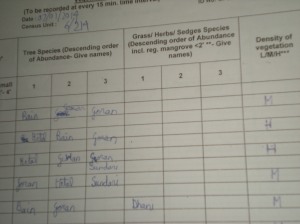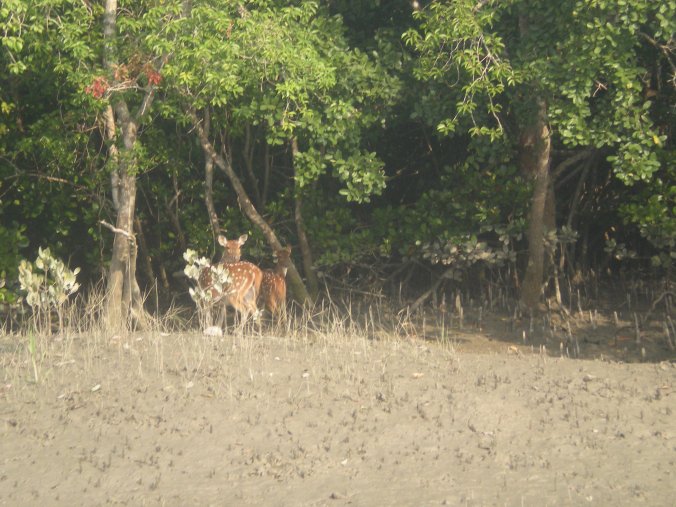After filling up our boat with foodstuffs and water, we – myself, two forest guards, the owner of our launch, and his assistant, bid adieu to civilisation, leaving the small town of pakhiralay (located opposite to the entrance to sajnekhali wildlife sanctuary)
far behind, as we journeyed into the heart of the throbbing wilderness that constitutes the Sunderbans Tiger Reserve. This reserve, spread over 2,585 sq. km, is the only place in the world where wild tigers exist in a mangrove habitat. We were participating
in the initial phase of the quadrennial tiger census carried out by the NTCA (National Tiger Conservation Authority).

The world’s only mangrove tigerland.
Enumerating wildlife scientifically involves demarcating “transects”, or pathways, in the forest and then noting down signs and direct sightings of the various species which are encountered while the transect is being negotiated. In the sunderbans, the various
transects coincide with the innumerable creeks which dot the mangrove forests.

A map showing the transects in Panchamukhani block of Sajnekhali Wildlife Sanctuary, STR.
Our transects lay mostly in the Panchamukhani and Pirkhali forest blocks, a part of the 362 sq. km Sajnekhali Wildlife Sanctuary, which forms the north-western part of the Sunderbans Tiger Reserve.
We had to fill up several forms stating the time and GPS location of each of our sightings of the various species and their signs. At half-hour intervals, we also had to state details of the flora noticed- the various mangrove species encountered, how tall
they were, etc.

Such sheets needed to be filled diligently!!!
We negotiated each river bend in extreme caution, hoping to spot tigers at the very next one. Unfortunately, the big cat itself remained elusive. But tiger pugmarks were everywhere-we even saw the pugs of a tigress and her three cubs at a riverbank. Another
set of pugs appeared to belong to a mating pair. These are the welcome signs of a thriving population.

Pugmarks left by the king of the mangroves.
Not that this population isn’t affected by any threats, though. Man-animal conflict is a significant problem in the Sunderbans, for this is an ecosystem where man is still preyed upon by quite a few species- the Bengal tiger and the estuarine crocodile being
the foremost among them. We saw two crocodiles during our boat survey, however, they were extremely wary and rushed into the water as soon as they saw us.

An estuarine crocodile basks in the sun opposite the Nature Interpretation Center at Sajnekhali.
The vast majority of those who get killed by tigers and crocodiles in the Sunderbans are honey-collectors and fishermen. Crab fishing often yields fair returns, but it is an extremely dangerous occupation, which, sadly, the poorest of the poor have no option
but to take recourse to. Numerous ecodevelopment initiatives have been launched by the authorities in the fringe areas of the Sunderbans in the recent past; however, many people continue to remain heavily dependent upon the forest. Sometimes, poachers sneak
into the reserve in the guise of crab fishers. While the direct targeting of tigers for their skin and bones has never been a common occurrence in the Indian sunderbans, there should be no let up in vigil.

The fisherfolk of the Sunderbans.
Naturally, there are few permanent residences for the forest staff of the Sunderbans which lie on terra firma. Several boats have been converted to “floating anti poaching camps” , for more effective patrolling. Nevertheless, the average age of a forest
guard in the Sunderbans is 52 years, and several posts lie vacant.
After having met no humans during the first day of our survey, we stopped at the first floating camp we came across on the second day. The guards there told us that a tiger had crossed the creek where the camp lay only half an hour ago. And sure enough, we
saw his huge saucer-shaped pugmarks on the opposite shore.
Our next encounter with Homo sapiens was of a different kind, for a boatload of tourists chanced upon us, as we were headed off towards our next transect. They initially thought that we were an errant tourist-carrying boat that had strayed into a
part of the forests where tourists are forbidden to go!!!
On that very same transect, we came across a small herd of chital- some 4-5 members of the group were visible. Chital, or spotted deer, form the bulk of the tiger’s preybase in the sunderbans. Chital sightings in sunderbans are few and far between, since they
are heavily reliant upon the few fresh-water ponds which exist on the Sunderbans. Poaching for meat has also played a significant role in depressing their density, which, at 13.3 per sq. km (according to a WII survey), leaves a lot to be desired.

Chital form the bulk of the tiger’s preybase in the Sunderbans.
Tigers in the Sunderbans also prey on rhesus macaques, wild boar(of which there are few), and monitor lizards, some of which can grow up to 7-8 feet in length.

Rhesus macaques are commonly seen at Sajnekhali.
After 3 days, the hectic census finally came to an end, with our sheets full of data regarding the time and GPS location of each sighting of wildlife and their signs. Even though i am a novice birdwatcher, i was able to identify common sandpipers, great
egrets, ospreys, purple herons, golden orioles and 4 species of kingfishers- black-capped, brown-winged, small blue and white breasted, among others. The Sunderbans, with over 230 recorded species of birds, is a dream destination for a birdwatcher.

A common sandpiper.

Great egret (Ardea Alba).
The results of our hard work were made available a year later- 76 tigers were estimated to exist in the Indian Sunderbans, compared to 70 in 2010. The need of the hour is to strengthen conservation initiatives in the Sunderbans, especially when it comes
to patrolling and monitoring. The mangrove tigerland, with its enchanting habitat, fierce tigers, lurking crocodiles, and soaring egrets is a unique component of our natural heritage which deserves to be jealously protected forever.

Postscript : This article is a tribute to Panchanan Mondal and Ghosh Babu, those awesome forest guards whom i accompanied during the census, and whose dedication and knowledge was a source of inspiration. These brave foot soldiers of the Sunderbans
are doing a wonderful job in possibly the most inhospitable tiger landscape in the world- serving with dedication day in and day out, inspite of having lost colleagues to tiger attacks in the past.
I also thank Joydip and Suchandra Kundu, eminent Kolkata-based conservationists, for their help and support, and Subrata Mukherjee, the then field director of STR, and his team. May they receive all the support they so earnestly need, in their war
to protect the mangrove tigerland.